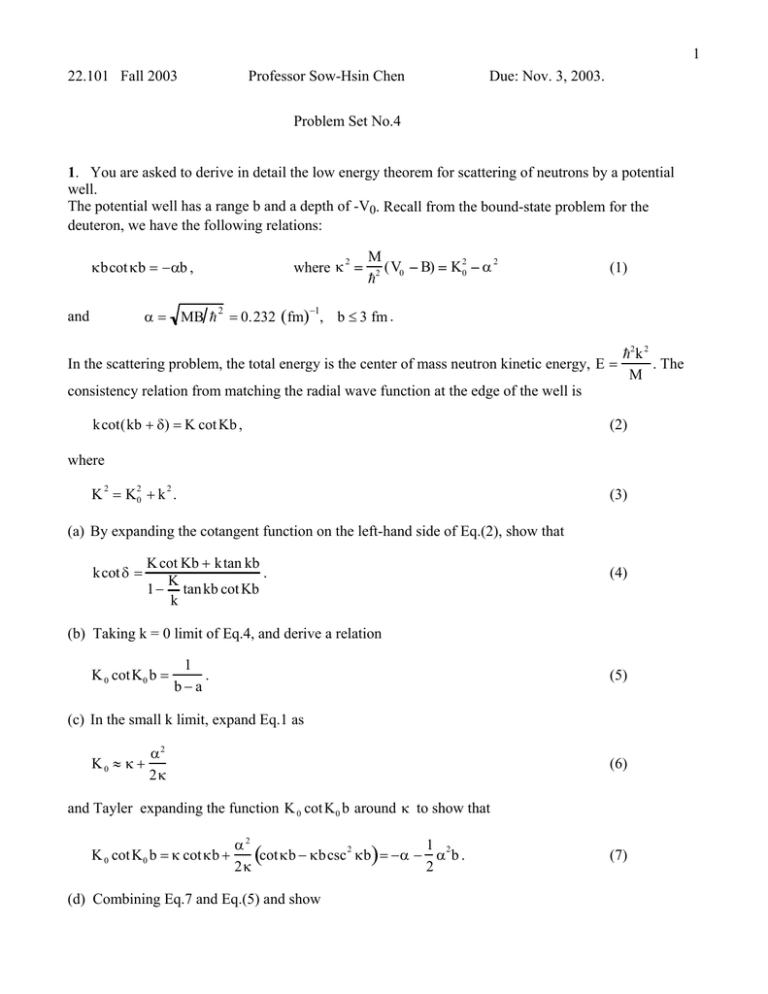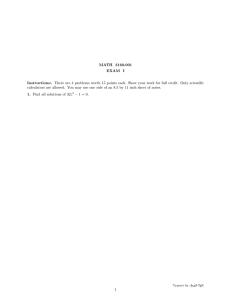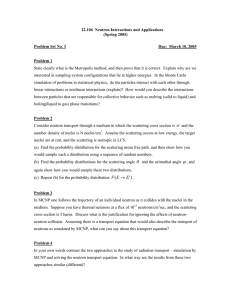1 22.101 Fall 2003 Professor Sow-Hsin Chen
advertisement

1 22.101 Fall 2003 Professor Sow-Hsin Chen Due: Nov. 3, 2003. Problem Set No.4 1. You are asked to derive in detail the low energy theorem for scattering of neutrons by a potential well. The potential well has a range b and a depth of -V0. Recall from the bound-state problem for the deuteron, we have the following relations: 2 where κ = κbcot κb = −αb , α = MB and 2 M 2 (V0 − B) = K20 − α 2 (1) = 0.232 ( fm) −1, b ≤ 3 fm . In the scattering problem, the total energy is the center of mass neutron kinetic energy, E = consistency relation from matching the radial wave function at the edge of the well is kcot(kb + δ) = K cot Kb , (2) where 2 2 2 K = K0 + k . (3) (a) By expanding the cotangent function on the left-hand side of Eq.(2), show that kcot δ = K cot Kb + ktan kb . K 1− tan kb cot Kb k (4) (b) Taking k = 0 limit of Eq.4, and derive a relation K 0 cotK0 b = 1 . b−a (5) (c) In the small k limit, expand Eq.1 as α2 K0 ≈ κ + 2κ (6) and Tayler expanding the function K 0 cot K0 b around κ to show that K 0 cot K0 b = κ cot κb + α2 1 2 2 cot κb − κbcsc κb) = −α − α b . ( 2κ 2 (d) Combining Eq.7 and Eq.(5) and show (7) 2 k2 . The M 2 a = b+ 1 1 (1 − αb) α 2 (8) This last relation shows that a small binding energy of the bound state will result in a large scattering length for the low energy scattering. k2 (e) Again using the approximation valid in the low energy limit K ≈ K0 + to show that 2K0 k2 1 1 2 ak 2 2 K cot Kb = K 0 cot K 0 b + (cot K0b − K0 bcsc K0b )= b − a − 2 bk − 2K (b − a)2 . 2K0 0 (9) (f) Combining Eq.4 and eq.9, to show finally the very useful low energy theorem kcot δ = 1 1 b3 1 − (b − 2 − 2 )k 2 . a 2 3a K0 a (10) Eq.10 means that for neutron energy E below 10 MeV, we have a cross section of the form ⎧ 1 ⎤⎫ b3 2 2⎡ σ(k) = 4πa ⎨1− k ⎢ a(a − b) + − 2 ⎥ ⎬ , 3a K 0 ⎦ ⎭ ⎣ ⎩ (11) 2 which shows clearly that for thermal neutrons the total cross-section is simply a constant value 4 πa , a very important result. 2. Show that in the limit k → 0 , the total n − p scattering cross section can be written as ⎛ ⎞2 tan K b 0 ⎟ . σ(k → 0) = 4πb2 ⎜⎜ 1 − K 0 b ⎟⎠ ⎝ (12) ( where b is the range of force in the square well potential, and K 0 = MV 0 / 3 2 ) 1/2 . Solve the S-wave scattering of a slow particle (kb << 1) by a repulsive potential barrier. ⎧+V0 V(r) = ⎨ ⎩ 0 r<b . r>b (13) Derive the scattering length a in terms of the potential parameters in the limit of zero energy. Derive the total cross section and show that as V 0 → ∞ the total cross section approaches a limit 4π b2 , which is four times the geometrical cross section of a hard sphere of radius b. 4. In order to perform a proton-proton scattering experiment at at E L = 10 MeV , one fills the 3 scattering chamber with 10 mmHg of H 2 gas at 0 C . The proton beam from a cyclotron has a diameter of 2 mm and has been calibrated to have a current of 5 µA. One detects the scattered proton beam at Θ L = 45 by a detector which subtends a solid angle of 10 −3 sterad. Assume the scattering volume of (0.2) 3 cm 3 and the differential cross section at this angle of 0.17 barns/sterad. Calculate the counting rate at the detector. 5. The fission cross section for thermal neutrons of natural uranium (isotopic composition 238 ) is 235 0.72% U 235, 99.27% U for σ f = 4.22 b. Calculate the fission cross section of pure U 10 thermal neutrons. If a thermal neutron flux φ = 10 neutrons/ cm 2 sec impinges on a thin target of natural uranium, how many fission events occur per second when the target is 0.01 cm thick? (Density 3 of uranium ρ = 18.68 gr / cm ).





